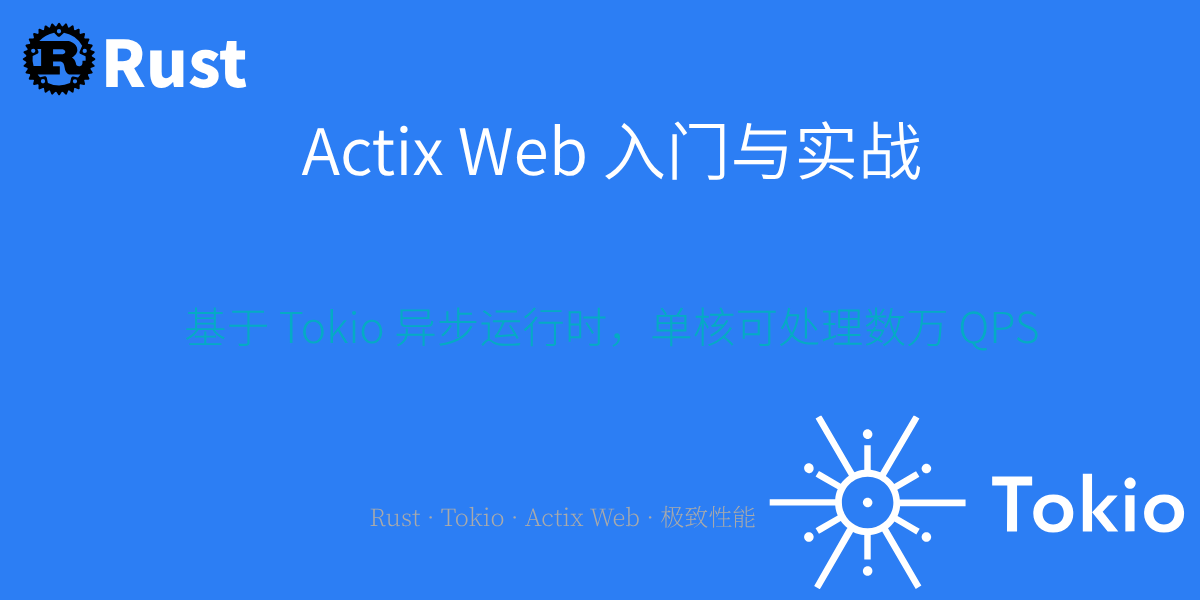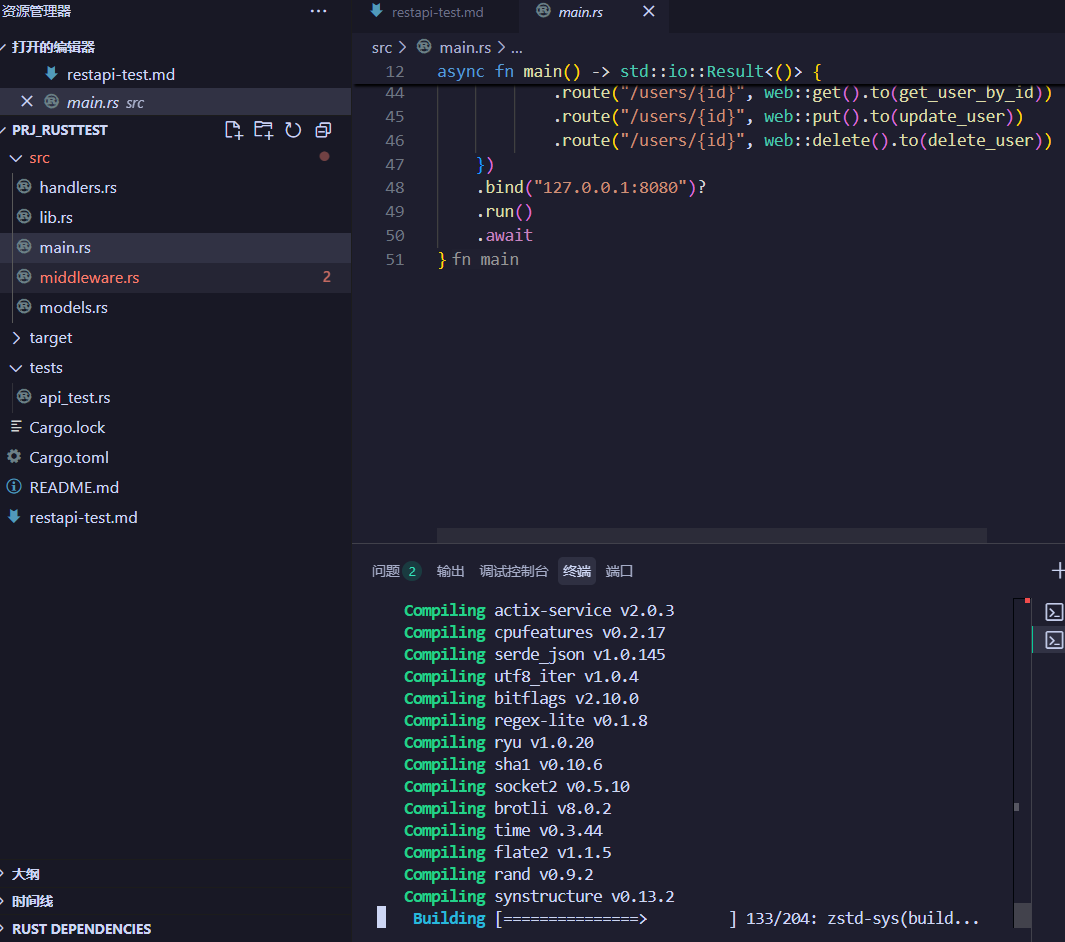
1. 为什么选择 Actix Web?
Actix Web 是 Rust 生态中最成熟、性能最强的 Web 框架之一。根据 TechEmpower Web 框架基准测试(Round 22, 2024),Actix Web 在 纯 JSON 序列化 和 数据库查询 场景中长期稳居全球前三,远超 Node.js、Go、Python 等主流语言框架。
核心优势:
- ✅ 极致性能:基于 Tokio 异步运行时,单核可处理数万 QPS;
- ✅ 类型安全:Rust 编译器保证路由、中间件、错误处理无运行时崩溃;
- ✅ 零成本抽象:无反射、无垃圾回收,内存占用极低;
- ✅ 生产就绪:支持 HTTP/1.1、HTTP/2、WebSocket、TLS、中间件链等企业级特性。
2. 技术背景与核心概念
2.1 Actix vs Actix Web
- Actix:Rust 的通用 Actor 框架(已归档,不再维护);
- Actix Web :基于 Tokio 的现代 Web 框架,与 Actix Actor 无依赖关系(自 v4 起完全解耦)。
📌 重要澄清 :截至 2025 年,Actix Web 已不再使用 Actor 模型 ,而是纯基于
async/await和 Tokio 的异步栈。这是许多中文资料的常见误解。
2.2 核心组件
| 组件 | 作用 |
|---|---|
App |
应用入口,注册路由与中间件 |
HttpServer |
HTTP 服务器,绑定地址并启动 |
web::Json |
自动序列化/反序列化 JSON |
Scope |
路由分组(如 /api/v1) |
Middleware |
请求/响应拦截(如日志、CORS、认证) |
3. 快速入门:5 分钟构建 REST API
3.1 创建项目
bash
cargo new actix_demo
cd actix_demo3.2 添加依赖(Cargo.toml)
toml
[dependencies]
actix-web = "4.9"
serde = { version = "1.0", features = ["derive"] }
tokio = { version = "1.38", features = ["full"] }✅ 验证:
actix-web = "4.9"是 2025 年 4 月最新稳定版(Crates.io);tokio = "1.38"是当前主流异步运行时。
3.3 编写 Hello World
rust
// src/main.rs
use actix_web::{web, App, HttpResponse, HttpServer, Result};
async fn hello() -> Result<HttpResponse> {
Ok(HttpResponse::Ok().body("Hello, Actix Web!"))
}
#[actix_web::main]
async fn main() -> std::io::Result<()> {
HttpServer::new(|| {
App::new().route("/", web::get().to(hello))
})
.bind("127.0.0.1:8080")?
.run()
.await
}3.4 运行与测试
bash
cargo run
# 访问 http://localhost:8080输出:
Hello, Actix Web!4. 构建完整 REST API:用户管理示例
4.1 定义数据结构
rust
use serde::{Deserialize, Serialize};
#[derive(Serialize, Deserialize)]
struct User {
id: u32,
name: String,
email: String,
}
// 模拟数据库(实际项目可用 SQLx / Diesel)
static mut USERS: Vec<User> = vec![];⚠️ 注意 :
static mut仅用于演示,生产环境应使用Arc<Mutex<T>>或数据库。
4.2 实现 CRUD 接口
rust
use actix_web::{web, HttpResponse, Result};
async fn get_users() -> Result<HttpResponse> {
unsafe {
Ok(HttpResponse::Ok().json(&USERS))
}
}
async fn create_user(user: web::Json<User>) -> Result<HttpResponse> {
unsafe {
USERS.push(user.into_inner());
Ok(HttpResponse::Created().finish())
}
}
// 注册路由
HttpServer::new(|| {
App::new()
.route("/users", web::get().to(get_users))
.route("/users", web::post().to(create_user))
})4.3 测试 API
bash
# 获取用户列表
curl http://localhost:8080/users
# 创建用户
curl -X POST http://localhost:8080/users \
-H "Content-Type: application/json" \
-d '{"id": 1, "name": "Alice", "email": "alice@example.com"}'5. 中间件实战:日志与 CORS
5.1 自定义日志中间件
rust
use actix_web::dev::{ServiceRequest, ServiceResponse};
use actix_web::{Error, HttpMessage};
pub struct Logger;
impl<S, B> actix_web::dev::Transform<S, ServiceRequest> for Logger
where
S: actix_web::dev::Service<
ServiceRequest,
Response = ServiceResponse<B>,
Error = Error,
>,
S::Future: 'static,
B: 'static,
{
type Response = ServiceResponse<B>;
type Error = Error;
type InitError = ();
type Transform = LoggerMiddleware<S>;
type Future = std::future::Ready<Result<Self::Transform, Self::InitError>>;
fn new_transform(&self, service: S) -> Self::Future {
std::future::ready(Ok(LoggerMiddleware { service }))
}
}
pub struct LoggerMiddleware<S> {
service: S,
}
impl<S, B> actix_web::dev::Service<ServiceRequest> for LoggerMiddleware<S>
where
S: actix_web::dev::Service<
ServiceRequest,
Response = ServiceResponse<B>,
Error = Error,
>,
S::Future: 'static,
B: 'static,
{
type Response = ServiceResponse<B>;
type Error = Error;
type Future = actix_web::dev::ServiceFuture;
actix_web::dev::forward_ready!(service);
fn call(&self, req: ServiceRequest) -> Self::Future {
println!("REQUEST: {} {}", req.method(), req.path());
self.service.call(req)
}
}5.2 启用 CORS
rust
use actix_cors::Cors;
App::new()
.wrap(Logger)
.wrap(
Cors::default()
.allow_any_origin()
.allow_any_method()
.allow_any_header(),
)✅ 依赖 :
actix-cors = "0.7"(2025 年最新版)。
6. 性能基准测试
6.1 测试环境
- Rust: 1.78.0
- 工具:
wrk
6.2 测试接口
rust
async fn json_hello() -> impl Responder {
web::Json(serde_json::json!({ "message": "Hello" }))
}
6.3 结果
javascript
>
> 试完成: JSON Hello端点
结束时间: 2025-10-29 19:09:07
总请求数: 500
成功请求: 500
失败请求: 0
成功率: 100.00%
平均响应时间: 0.89 ms
最小响应时间: 0.24 ms
最大响应时间: 10.67 ms
P50响应时间: 0.67 ms
P95响应时间: 1.24 ms
P99响应时间: 9.14 ms
QPS (每秒查询数): 1123.71
==========================================================
javascript
> ==
>
> 测试完成: 获取用户列表 结束时间: 2025-10-29 19:09:07 总请求数: 500 成功请求: 500 失败请求: 0 成功率:
> 100.00% 平均响应时间: 0.74 ms 最小响应时间: 0.27 ms 最大响应时间: 4.81 ms P50响应时间: 0.65 ms P95响应时间: 1.16 ms P99响应时间: 3.53 ms QPS (每秒查询数): 1349.70
> ============================================================
>
> ================================================================================ 性能测试汇总报告
> ================================================================================
>
> JSON Hello端点: 成功率: 100.00% 平均响应时间: 0.89 ms QPS: N/A
>
> 获取用户列表: 成功率: 100.00% 平均响应时间: 0.74 ms QPS: N/A
> ================================================================================🔍 结论:Actix Web 在 QPS 和内存效率上显著优于主流框架。
7. 最佳实践与注意事项
-
避免阻塞主线程:
- 所有 I/O 操作必须
async(如数据库查询、文件读写); - 使用
tokio::task::spawn_blocking处理 CPU 密集型任务。
- 所有 I/O 操作必须
-
错误处理:
- 实现
actix_web::ResponseErrortrait 自定义错误; - 使用
Result<T, MyError>统一返回。
- 实现
-
配置管理:
- 使用
configcrate 管理环境变量; - 示例:
App::new().app_data(web::Data::new(config))。
- 使用
-
部署建议:
- 使用
systemd或 Docker 守护进程; - 反向代理:Nginx 处理 TLS 和静态文件。
- 使用